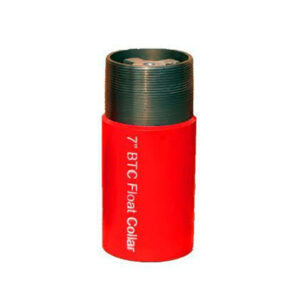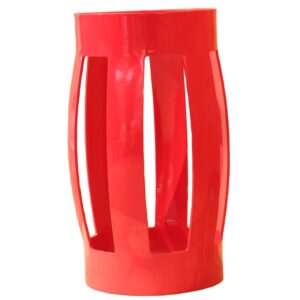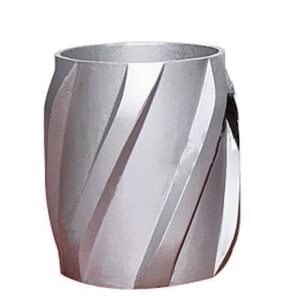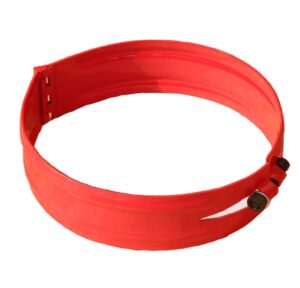Making It Precious ! Making It better ! Making it easy ! Making It simple!
SPRING BOW AND SOLID RIGID CASING CENTRALIZERS
Casing centralizers, also known as drilling centralizer, are important cementing tools to position the casing uniformly inside the wellbore to offer a more uniform distribution of cement slurry around the casing.
They can also reduce the friction between casing and wellbore and keep the casing from hitting the wellbore walls.
By this tool, a continuous annular clearance around the casing allows the cement to completely seal the casing to be casing to the boreholes wall.
All our casing centralizers are accord with API RP 10-2 recommendations.
BOW SPRING CENTRALIZERS
Bow spring centralizers have slightly larger diameter than the wellbore, which is effective in vertical and slightly deviated wellbores to centralize the casing in borehole so as to improve the cementing efficiency.
Bow spring centralizers are available in single piece, hinged and slip-on types with or without welding process.
Adjustable bow heights and full ranges of sizes ranging from 4-1/2″ to 20″ can satisfy almost all cementing projects in oil and gas cementing constructions.
The starting force testing and restoring force testing of our bow spring centralizers are performed in accordance with API 10D Standards.
SOLID RIGID CENTRALIZERS
Solid rigid centralizers is built using cast aluminum or steel materials. Because the diameter is smaller than the wellbore, so the solid rigid centralizers are not as effective as bow spring centralizers in vertical wells. But they are rugged and works well in the deviated wellbores.
Solid rigid centralizers are available with straight or spiral vanes & rollers. And the length can be regular or short lengths.
4-1/2″ to 20″ standard sizes and customized service help you find the best solid rigid centralizers for oil and gas cementing projects.
STRAIGHT/SPIRAL VANE SOLID CENTRALIZER
- Available in straight or spiral vane types
- It is used in areas where a good primary cementing job is required, including deviated and horizontal wells, liner overlaps and shoe joints.
- Spiral vane is developed in response to the need for better cementing and can provide optimum flow area in high deviated and horizontal well.
- Reduced flow area between the spiral blades produces a vortex motion of the fluids for more fluid velocity with direction.
- Made of cast steel, which is high tensile and solid for shock and impact resistance.
- 360 degree overlapping solid vanes provide maximum wall contact and fluid swirl.
- Powder coating treatment provide excellent corrosion and rust resistance performance.
- Vane ends are beveled 30 degree relative to the casing centerline to provide excellent lead into restrictions and reduced drag when running in the wellbore. Besides, it keeps running forces at a minimum.
- Wide vanes distribute load from the casing string into the wellbore without gouging.
- Standard size is 4-1/2″ to 20″. Any special sizes or combinations can be customized on request.
- Available in with or without set screws for eliminating of stop collars.
HINGED BOLTED STOP COLLARS
Hinged bolted stop collar is intended to lock on the casing without being slipped over the casing and offers quick and easy installation. It has higher holding forces than the centralizer starting force.
It utilizes a nut-bolt assembly to fix together and draws the stop collar into a friction grip around the perimeter of the casing.
Performance features
- Can be locked on the casing pipe without having to be slipped on at the end of the casing pipe.
- The locking mechanism is at 180° of the hinge.
- Cross-bolt design makes it efficient and user-friendly.
- Economical stop collars.
- Suitable for subcritical annular tolerance.
CEMENT FLOAT SHOES AND COLLAR SIZES AND CONFIGURATION
Float collar and float shoe are important floating equipment in petroleum and natural gas fields. They are used to guide the casing to set in the hole and ensure the quality of cementing. They are widely used in the lower section of the wall to help decrease strain on the derrick while directing packaging past edges and bod zones in the opening.
The float shoe contains a backpressure valve that prevents fluids from entering the casing while the pipe is lowered into the hole and prevents cement from flowing back into the casing after placement, while enabling circulation down through the casing.
The float collar include a backpressure valve and serve basically the same function as the float shoe.
The float collar is run in a casing assembly, usually several joints above the float shoes. It provides a set for the cement plus, to help top plugs shut off fluid flow and prevents over-displacement of the cement. The space between the float shoe and float collar provides a containment area to entrap the likely-contaminated fluids from the wiping action of the cementing plugs, securing the contaminated fluid away from the shoe where a strong cement bond is of primary importance
Single Valve Float Shoe & Collar
The single valve type of float shoe and collar is the most economical and common seen type, which ensures the valve the maximum circulation rate in vertical, horizontal and deviational wells. And all materials are PDC drillable and all production is processed on CNC machines.
The plunger type single valve can help to prevent cement back-flow, provide casing buoyancy during the run-in. It can also act as an an internal BOP during the process of running and cementing the casing.
Performance feature
- The most economical and common seen type
- Free-floating ball abrades
- Valve parts will not damage PDC bits
- All materials are PDC drillable
- Fast drill-out and no springs
- Operator-controlled buoyancy-regulated by filling casing at surface
Options
- Available with cement nose, aluminium nose or bladed nose.
- Available in 3-1/2″ to 30″ sizes.
- Special sizes/configurations are available as customers’ requirement.

SPECIFICATION
Material: floating equipment (float shoe and float collar) is made of seamless casing grade steel. And we can supply all grade of steel. And all our materials are PDC drillable.
Connection thread:
API: EUE, NUE, LTC, STC, BTC, Vam Top
CONVENTIONAL/STANDARD AND NON-ROTATIONAL CEMENTING PLUGS
Cementing plugs are used to remove the mud during cementing operations. Top cementing plugs and bottom cementing plugs are used in the cementing process. The top and bottom cementing plugs general have different colours (bottom plugs are red and top plugs are backs) in production for easy usage in operation.
The top cementing plug has a solid body that provides positive indication of contact with cementing floating collar and bottom plugs through an increase in pump pressure. The top cementing plug has a solid body that provides positive indication of contact with cementing floating collars and bottom plug through and increase in pump pressure.
The Bottom cementing plugs with a hollow body is installed ahead of the cement slurry to minimize contamination by fluids inside the casing prior to cementing
CONVENTIONAL/STANDARD CEMENTING PLUG
Conventional top and bottom cementing plugs significantly reduce the drill out time to save cost. The bottom plug separates the cement from drill mud and features a rubber diaphragm which is opened once the plug has landed and latched into the conventional cementing float collar.
The top cementing plug is used as a flow-up plug to displace cement to provide a anti-rotational feature to eliminate rotation during drilling and save drill out time when it is latched into the upper end of the bottom plug.
Performance feature
- Aim to reduce the drill out time and save cost.
- Top plugs are used as a flow plug to displace the cement and land on the upper end of the bottom plug.
- The body consists of ebonite inserted molded with elastomer, which is easy to fracture than the rubber and aluminium structure, thus reducing the drill out time significantly.
- No metal parts are used therefore the plugs are PDC drillable.
Options
- Available in sizes from 4-1/2″ to 20″
- Available in NR, SBR, NBR and HNBR grades.






